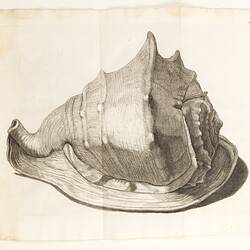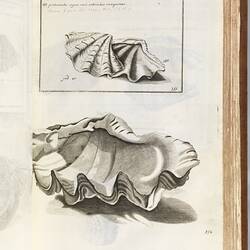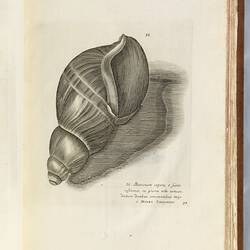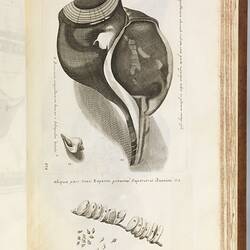Summary
Martin Lister's 'Historiae sive synopsis methodicae Conchyliorum' was published in London between 1685 and 1692 and contains over 1000 engraved copperplate engravings, presenting over 2000 figures of shells and molluscs from around the world.
Martin Lister (1639-1712) was a royal physician to Queen Anne, a vice president of the Royal Society, and the first scientific conchologist and arachnologist. He is also recognised for his discovery of ballooning spiders, as the founder of conchology, and as the inventor of the histogram. Lister also donated the first significant natural history collection to the Ashmolean Museum in Oxford, which is still held there today, though some of his shell collection is housed at the Natural History Museum in London.
Held in high esteem in the scientific community, Lister authored multiple works in his lifetime including; 'Historiae animalium Angliae tres tractatus' (1678); 'Historiae Conchyliorum' (1685-1692); 'Conchyliorum Bivalvium' (1696), and Journey to Paris (1699) a bestselling travel guide to Paris. The latter was so popular that it was reprinted for the next three centuries in both English and French.
'Historiae sive synopsis methodicae Conchyliorum' was a family affair as the meticulous copperplate engravings were crafted by Lister's daughters, Susanna (1670-1738) and Anna (1671-1704). Lister was disappointed with the work of already established artists, who were unfamiliar with the instruments, technologies, and creatures Lister worked with, and as a result, he decided to teach his daughters the art of science, instructing them how to illustrate the specimens he was studying.
Lister employed his daughters from an early age and credited them both as the illustrators and engravers of 'Historiae sive synopsis methodicae Conchyliorum'. Both Susanna and Anna are listed as contributors on the title page of each of the four parts that make up 'Historiae sive synopsis methodicae Conchyliorum'.
Both Susanna and Anna were highly skilled scientific artists. They completed drawings of shells and molluscs which they engraved onto copper plates for printing, also dissecting the specimens they illustrated. Many of their original water-colour drawings still exist at Oxford. They created highly accurate three-dimensional illustrations, often presenting multiple perspectives for the same specimen. Most drawings of the specimens presented in 'Historiae sive synopsis methodicae Conchyliorum' were drawn to scale from the specimens that Lister had collected from around the world.
The first edition of 'Historiae sive synopsis methodicae Conchyliorum' was published in four parts between 1685 and 1692, and it is thought that the printing was done by the family at home, rather than taken to a professional printing firm. A second edition was produced almost immediately in 1697.
In 1712 Lister donated the original copper plates to the Ashmolean Museum, and later curator of the museum, William Huddesford, published a third edition of the work in 1770 with revised text based on Lister's manuscripts. A final edition known as the Dillwyn edition, which included an index, was printed in 1823. This edition is technically the fourth edition but is known generally as the third.
Physical Description
The work was published in four parts and later bound to create one volume measuring 32 cm in height. The contents are entirely engraved, with engraved text in Latin. The engraved text would have been worked in reverse, and is minimal, generally consisting of a name and a short description for each specimen. The volume is leather bound, with a gilt-decorated spine with 6 sections and 5 raised bands, and an embossed pattern and symbol on the spine and front cover. It has a 'National Museum of Victoria' raised stamp dated 1854 on the end cover. Originally issued in parts, few copies are identical and vary in the number of engravings. This copy has 612 pages. There are no printed page numbers, but each plate has been individually numbered. The last plate is numbered 1057. There are ten fold-out engravings.
Significance
Lister is thought to be the founder of conchology in England and his work 'Historiae sive synopsis methodicae Conchyliorum' is the first comprehensive, illustrated work on conchology in Western science. It is also the first work to attempt a systematic classification of molluscs.
Produced in the late 17th century before the development of the binomial system of classification by Carl Linnaeus, 'Historiae sive synopsis methodicae Conchyliorum' is considered an historically significant work as it attempted to create standards for the classification and identification of species. Lister's work was highly sought after as a reference book and was cited by both Linnaeus and Darwin.
This work is also significant because it highlights the skills and contributions of women in 17th century science. Women often worked in less visible roles such as artists, engravers or colourists, and were frequently enabled in their scientific pursuits through family or other social connections. In addition to the illustrations for their father's work, Anna and Susanna Lister also contributed illustrations to the Philosophical Transactions of the Royal Society of London. They are thought to be the first female artists to use a microscope to aid their scientific illustrations.
This is the oldest book in the Museums Victoria Library collection, and the only work dating from the 17th century.
More Information
-
Collecting Areas
-
Illustrator & Publisher
-
Illustrator & Publisher
-
Publisher
-
Publisher
William Huddesford
Lister donated over a thousand books and manuscripts to the Ashmolean Museum and William Huddesford was the keeper of the Ashmolean at the time. Huddesford later published a third edition of this work. -
Author
-
Category
-
Discipline
-
Type of item
-
Overall Dimensions - Closed
231 mm (Width), 79 mm (Depth), 321 mm (Height)
-
References
Amgueddfa Cymru - Museum Wales (2018). Lister's Historiae Conchyliorum: a seventeenth-century shell book'. [online] Museum Wales. Available at: [Link 1] Kemp, M. (1990)?The Science of Art, New Haven: Yale University Press. Reich, E.S. (2010). 300-year-old engravings shed light on women in science. Nature, 2010(Dec). doi:[Link 2] Roos, A. M (2019). Martin Lister and his remarkable daughters the art of science in the seventeenth century. Oxford Bodleian Library. Roos, A.M. (2011). The Art of science: a 'Rediscovery' of the Lister Copperplates. Notes and Records of the Royal Society, 66(1), pp.19-40. doi:[Link 3] Wilkins, G.L. (1953). A catalogue and historical account of the Sloane Shell Collection. Bulletin of the Natural History Museum (Natural History). Historical Series., v.1 (1953-1959)(1), pp.1-48. doi:[Link 4]
-
Keywords
Shells, Illustrations, Natural History, Printing, Molluscs, Early works to 1800, Conchology, Zoology





